- Bernard Preston homepage
- Legumes
- Fava Beans Nutrition
Fava beans nutrition
Fava beans nutrition is noteworthy for its high vegetable-protein content and dopamine precursors.
You are an exceptional person if you are reading this page because the subject is of little interest amongst people scouring the web; perhaps it is because they are using the other name for favas, namely the broad-bean.
Yet at times it rises to being the fourth most-popular page at this site.
You have probably arrived here for one of two reasons. Either you have Parkinson's disease and are looking for a natural form of treatment or you are planning to reduce the red-meat on your plate; both are perfectly valid.
Three other possible reasons are because you have an "essential" tremor, are developing macular-degeneration or have a stomach ulcer; this is not small beer. Fully grasping the contents of this page could make a profound difference in your dotage.
This page was last updated by Bernard Preston on 9th January, 2024.
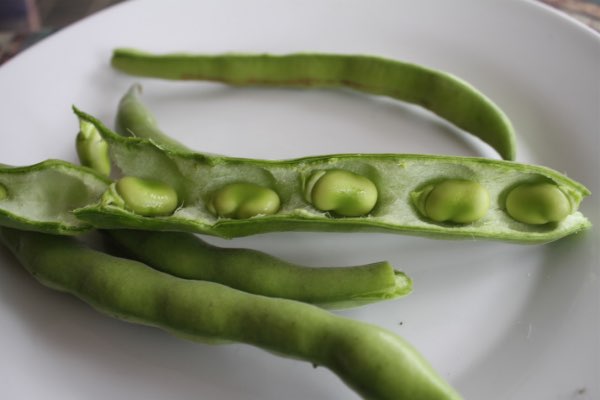
Favas are probably the most hated bean in the world and for good reason. I disliked them so much myself in my youth that I avoided them for over fifty-years. The reason is simple; old and starchy, they are perfectly horrid; and their nutrition is lessened too.
But once a few years back, when I was served fresh baby fava-beans at a dinner I realised that for half a century I had been denying myself one of nature's delights.
There are three good reasons to grow and enjoy fava beans regularly; they do not thrive as well in the summer heat by the way, so you may need to freeze them if you want some for year-round nutrition. I hate to recommend the dried ones; I do not like them at all.
However this year we have grown them through the summer and they have done reasonably well.
Benefits of fava beans
- They have the second greatest amount of vegetable-protein of all legumes; nearly a quarter of the seed.
- They have all the essential amino acids; they are a "complete" protein like eggs, meat and dairy products.
- They taste absolutely delicious when enjoyed young.
- They are a far better source of dopamine for those suffering from the neurodegenerative diseases than the very expensive drugs; which have awful side-effects.
- You are less likely to get ulcers or macular-degeneration.
Fava beans nutrition
Fava beans nutrition is about the treatment of Parkinson's-disease; and I would suggest perhaps the prevention of it, though I could find no research confirming that.
The reason is that they contain large amounts of two chemicals, levo and carbidopa that are absolutely vitally needed by the body. Ask any person suffering from the disease and they will tell you that life without these substances is not worth living.
Of great significance is sprouted broad beans have twenty times the amount of these dopamine precursors; it's very simple.
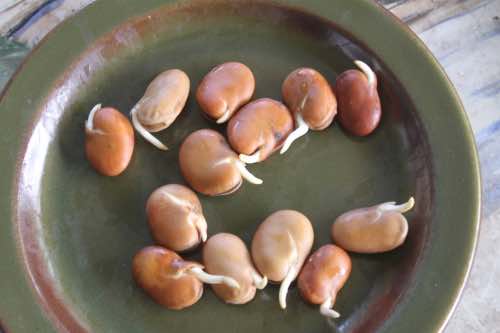 Twenty times the L-dopa
Twenty times the L-dopaThis is all quite complex biochemistry so we will leave that until last. If you have the disease and want to reduce or go without the medication then brace yourself; and get ready to have your brain stretched. It is important.
And start looking for either a packet of seeds to plant in your garden; or a source of the fresh, young beans.
Vegetable protein
Whether we like it or not, within a few short decades, humans beings are going to be getting most of their protein from vegetables; more specifically, legumes.
There are at least four prominent reasons.
- Meat is going to become inordinately expensive; in fact it has already.
- It takes one-tenth of the water to produce the same amount of protein from legumes as from animals.
- Climate-change from the waste produced by animals rising into the atmosphere is going to destroy the planet; it is already.
- That waste is polluting our water, already in seriously short-supply.
For many that is a problem for another day and the next generation to sort out; for the present we will continue to enjoy predominantly meat in some form for our protein.
But perhaps you like me have a tender conscience and do not want your children stomping on your grave and cursing the way we contributed to the destruction of the planet. After all they will inherit it from us.
Then it is time to start making a place
for vegetable-protein in your food; and there is no better place to begin
than with fava beans nutrition. It is being called the Flexitarian way of life; still eating meat but less of it.
Therein lies the rub. It will mean you have to start growing them yourself, unless you live in countries like Morocco and parts of England where they are available in the marketplace; and interestingly in all five Blue Zones of the world where ten-times as many live to vigorous, ripe old age. It is not the slightest bit difficult but they do need to be firmly staked.
Dried or old and starchy, they are perfectly horrid. How to plant broad beans is not rocket science but it will take you down new and enticing paths like getting your garden-soil ready. In fact, most folk reading this page, have probably also already considered the subject and are even practising it.
Just how much protein we should be eating each day is a controversial subject, not to be discussed here; but as a rough guide, the average person needs about 50g per day, and a cup of fava-beans would provide almost all of that. Add an egg and you are home and dry.
Getting your garden soil ready is all about the virtues of humus and composting.
There is a lot of potential merit in minimally-processed vegetable protein, if it actually means less red meat consumption.
However there is plenty of contention concerning the highly-processed extracts that are being sold today.
Absolutely delicious fava beans
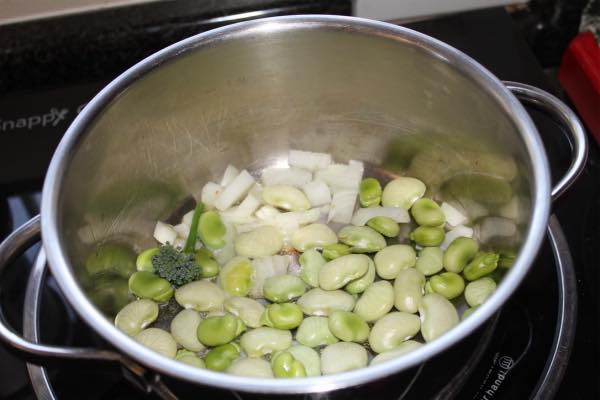
The second reason I propose to enjoy fava beans is that they are absolutely delicious; if you can get them young and fresh. Otherwise, forget it and stick to lentils and chickpeas.
I am writing here from a standpoint of practical experience. Ever since that day when I was deceived into eating young favas, not knowing what they were, we have been growing and enjoying them for over two-thirds of the year.
During the hot summer months, we rely on pole beans and late in the season limas, another favourite legume. Year round vegetable protein is our goal. Not that we are vegetarians but with so much metastatic disease about in our meat-loving family, I am determined to go down the road less travelled.
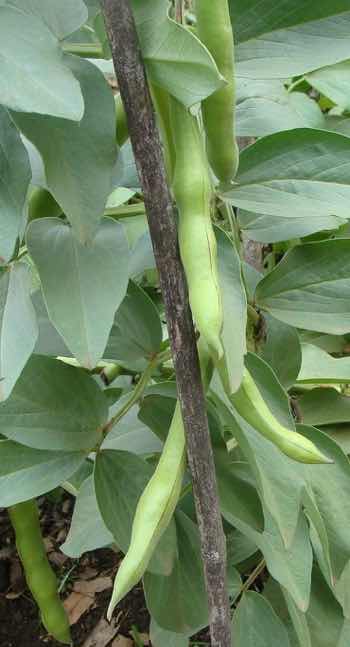
And I will add that if you are prepared to take the time to grow and cook your own fava beans, they are absolutely delicious; and you only have to simmer them for about five-minutes. It is so easy.
We try quite hard to eat two different legumes fresh from the garden every day; okay, I will admit it, I am a bit of a fruitcake. Call me neurotic if you will but perhaps if you have witnessed first hand what malignancies can do to your family, then you will understand. In that pot above is a mixture of fava and lima beans. I will be turning that into Eggs Hilton.
I will admit legumes generally do not have much flavour; we add plenty of chili and garlic; and mix them with other vegetables like broccoli and spinach. Always enjoyed with onions for their allicin benefits.
Parkinson's disease
Parkinson's disease and fava beans nutrition are intimately linked; these legumes are the only common natural source of pharmaceutical amounts of L-DOPA. Thus they can be used successfully in the treatment of the condition in many but not all cases. There are however numerous caveats.
- You will have to reduce the amount of medication taken.
- You will need a continuous supply of favas, also known as broad-beans.
- The dose may be difficult to manage; you will need to weigh the beans and be prepared to experiment.
On the plus side, the medication is very expensive ($2,500 per year) and has nasty side-effects. Those who use fava beans nutrition claim a smoothing effect which is much longer lasting and there are far less of the dystonias.
There is another big plus. Fava beans are also a natural source of C-DOPA; more about that below.
My strong recommendation is that you first decide how you are going to grow them yourself so that you can pick them every morning from your garden, as I do; or find someone who can supply you daily or at least several times a week. We enjoy Eggs Parkinson's disease frequently because I too have a tremor.
Spring: green peas and fava-beans.
Midsummer: Pole-beans and frozen fava-beans.
Autumn: Pole-beans, limas and favas.
Winter: Limas and fava-beans.
Read more at how to plant broad beans.
Blanching and then freezing broad beans for the inbetween periods works very successfully.
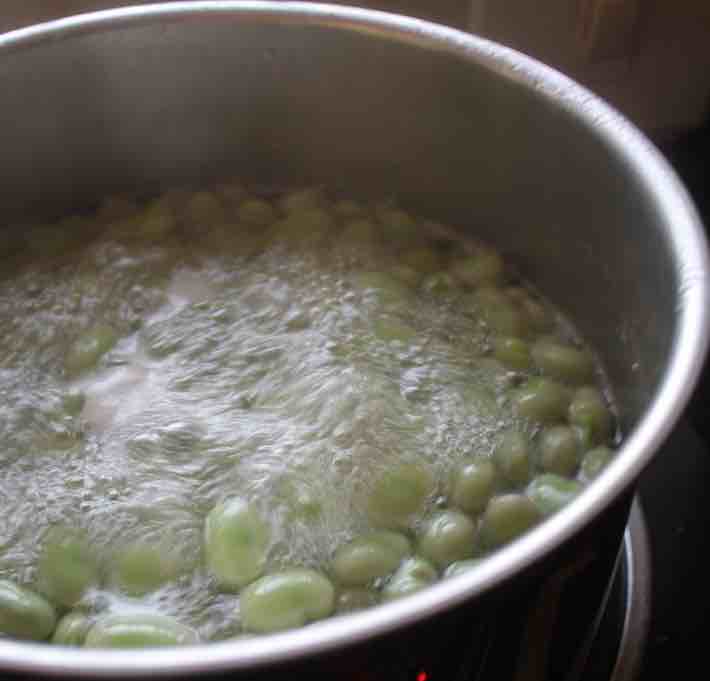 Blanche the fava beans for three minutes, drain and freeze
Blanche the fava beans for three minutes, drain and freezeGDNF
Researchers have reported that infusing a protein called GDNF directly into the brain resulted in major changes in a key area called the substantia nigra affected by Parkinson's disease.
Alas the experimental treatment failed to improve the symptoms of the disease though.
Enjoying a steady supply of fava beans nutrition delivers levodopa in a form which can cross the blood-brain barrier and have complete access to the part affected by Parkinson's disease. Moreover research shows that there is immediate benefit and lessening of symptoms.
Pharmaceutical companies of course would far rather you took their very expensive but less effective drugs.
Ulcers and fava beans
A plentiful supply of dopamine, at least half of which is synthesised in the colon also gives protection against gastro-duodenal ulcers.
The happy tum is now being called the second-brain by researchers; it is profoundly important for the prevention of the neurodegenerative conditions like Parkinson's disease.
Macular degeneration
Patients with Parkinson's disease taking dopamine medication are much less likely to get macular degeneration; it is the most common form of adult-onset blindness.
L-dopa from your fava beans gives profound protection for your eyes too; adult onset macular degeneration is the chief cause of blindness in those over fifty. There is a specific dopamine receptor on the capillaries behind the retina that prevents the proliferation of new blood vessels that characterises AMD.
Researchers have found that going on to Parkinson's medication (synthetic L-dopa) delays the onset of AMD by 4 years; the natural source in fava beans may be even more effective[6].
Lutein[3] also helps prevent the onset of age-related macular degeneration. Zeaxanthin[4] is another of these phytonutrients. Over five million Americans are needlessly blind and many more partially sighted simply because they don't get these nutrients from their food; this is not small beer obviously.
The biochemistry
The biochemistry of Parkinson's disease is complex but you will at least need to grasp some of the underlying processes. Here is a very simplified version.
L-DOPA is an amino acid; it is the precursor of several extremely important neurotransmitters.
It is rarely found in the diet; only in those parts of the world where fava beans are grown. It is synthesized normally in the brain from another amino-acid called tyrosine, fortunately in many protein foods such as dairy, fish and fowl; nuts and limas too.
In the Substantia Nigra, it is converted into a neurotransmitter called dopamine which is then supplied to many other parts of the brain called the basal ganglia, one of the functions of which is inhibition to several motor areas. Without it the various dystonias of speech, lips and limbs occur; there is loss of precise control of voluntary movement affecting the gait and causing tremors.
Newsletter
Our newsletter is entitled "create a cyan zone" at your home, preserving both yourself and Mother Earth for future generations; and the family too, of course. We promise not to spam you with daily emails promoting various products. You may get an occasional nudge to buy one of my books.
Here are the back issues.
- Lifestyle and ideal body weight
- What are ultra-processed foods?
- Investing in long-term health
- Diseases from plastic exposure
- Intensive lifestyle management for obesity has limited value
- A world largely devoid of Parkinson's Disease
- The impact of friendly bacteria in the tum on the prevention of cancer
- There's a hole in the bucket
- Everyone is talking about weight loss drugs
- Pull the sweet tooth
- If you suffer from heartburn plant a susu
- Refined maize meal and stunting
- Should agriculture and industry get priority for water and electricity?
- Nature is calling
- Mill your own flour
- Bake your own sourdough bread
- Microplastics from our water
- Alternative types of water storage
- Wear your clothes out
- Comfort foods
- Create a bee-friendly environment
- Go to bed slightly hungry
- Keep bees
- Blue zone folk are religious
- Reduce plastic waste
- Family is important
- What can go in compost?
- Grow broad beans for longevity
- Harvest and store sunshine
- Blue zone exercise
- Harvest and store your rainwater
- Create a cyan zone at your home
Vitamin B6, pyridoxine is required in the conversion of the precursor to dopamine.
The dopamine produced by the Substantia Nigra also has many other functions in the brain; the neurodegenerative Parkinson's disease has a wide ranging effect on the patient, since these cells in the nucleus are destroyed.
Nitrates used as preservatives in bacon, for example and reheated cooking oils in fast-food restaurants have been fingered as two causes of the disease; and many other chemicals. It is the fastest growing neurodegenerative condition in the world.
On the other hand, regularly eating the spice turmeric(1) and coloured foods rich in flavonoids(2) protects the Substantia Nigra.
Parkinson's disease affects roughly one in two hundred and fifty adults in America; it's far worse in China.
Carbidopa
L-dopa is converted to its cousin, this other neurotransmitter both before and after it enters the brain. Large amounts in the muscles would cause involuntary writhing movements.
In the normal healthy person, this carbidopa, also found in large amounts in fava beans inhibits this conversion to the neurotransmitter.
L-dopa does not form the neurotransmitter before it reaches the brain preventing these spasms.
Like L-dopa, the carbi isomer cannot enter the brain proper.
And thus does not inhibit the conversion of L-dopa to the neurotransmitter in the Substantia Nigra.
Parkinson's patients must either get their carbi-D from fava beans
nutrition or as a drug to reduce the conversion of the nutrient to dopamine in
the peripheral muscles of the body. These legumes provide both isomers of the phytochemical.
Pyridoxine
Once the nutrient has entered the Substantia Nigra, the dopaminergic cells as they are known, convert it to the neurotransmitter; for this to happen correctly vitamin B6, or pyridoxine is required.
All normal people but especially those suffering from Parkinson's disease, must have adequate amounts of pyridoxine in their diet; without it all the fava beans nutrition in China will not help a scratch.
Those who have read Fearfully, and wonderfully made, would agree that it is no coincidence that fava beans nutrition is also a good source of pyridoxine.
The good Lord made them all. It is also widely distributed in various grains, meat and eggs; and vegetables too. Nevertheless, circulating levels in the blood are low in many folk.
Chickpeas are the richest source of pyridoxine; make hummus in your kitchen every week. Vitamin B6 and frailty syndrome makes for an interesting read; it really is an extremely important nutrient for all and sundry.
Urine
Do notice that favas amongst many other foods can colour your urine; it is quite normal for it to turn brown after enjoying the beans. If it remains dark then it's best to let your doctor check using a dip stick; liver and kidney disorders can also have this affect.
Eyesight
Some of the earliest symptoms of Parkinson's Disease are seen in the eyes; due to the depletion of dopamine. The neurotransmitter is vitally important for normal sight.
Double vision, dry eyes and inability to blink for example are all caused by dopamine depletion[5].
Daily consumption of fava beans would greatly help the sight of those suffering from the disease by providing L-dopa, the precursor of the neurotransmitter.
Take home
The take home from this is that the brain must have both the Levo and Carbi isomers otherwise it is unable to produce dopamine as happens normally in the healthy Substantia Nigra. The Parkinson's patient can either get them from medicines or if they are lucky, fava beans nutrition may be able to supply all or part of their needs.
Either way living without dopamine is almost impossible.
Prevention of Parkinson's disease
I have been unable to confirm or even suggest really that fava beans nutrition would help prevent Parkinson's disease in humans; but it certainly has been shown in experimental mice. It is common sense that it would but it is yet to be conclusively proven; sometimes our logic can be quite erroneous.
In any case eggs Parkinson's disease makes a wonderful breakfast. We have it daily for much of the year; green beans in the growing season and then frozen or sprouted for the other months.
There are many other reasons confirming that those who frequent fast food restaurants on a regular basis and those who eat processed meat full of nitrates are on the road, not paved with good intentions but destined to suffer from serious illnesses; one of them is Parkinson's Disease.
There is also evidence that an unhealthy colon, deficient in the normal flora is also the source of many of the problems causing the neurodegenerative diseases. Taking a probiotic or enjoying these kefir benefits is the solution.
We agree with Hippocrates, the Father of Medicine, when he said let your food be your medicine; amen.
Aquafaba
After cooking legumes such as fava beans or chickpeas, you will be left with a viscous, brownish and frankly smelly liquid. Usually it is discarded but it in fact does have protein, carbohydrate and other plant compounds.
What is particularly interesting is its use as a emulsifying and foaming agent; and for thickening instead of cornstarch or nasty chemicals.
It can be used instead of egg white; I confess I have not tried it yet but plan to next time I make ice cream.
According to Wikipedia, use 2 tablespoons of aquafaba to replace the white of one egg. It takes a little longer to blend apparently.
My one initial concern is that the phytates in your fava beans are reduced by the cooking and rinsing process; are we putting them back into our food? They hinder the absorption of minerals.
Keto and banting diets
I do not believe in diets.
Diet is a dirty four-letter word and should be expunged from our thoughts and speech. Strong research shows that none of them work; after a year only 5 percent of folk have lost weight and many have actually put on extra unwanted pounds. We all know this only too well.
However the ketogenic and banting diets do have some merit; except that they prohibit the use of legumes because of their carbohydrate content. By turning us away from the protection of beans and peas like favas and forcing us to eat more meat for protein, they are setting us up for other diseases.
Personally I would rather die from a good clean heart attack from too much starch and fat in the diet than from a nasty neoplasm that killed me slowly because I ate a lot of red meat.
So I have come up with the "Modified Banting Diet" which allows legumes but strictly limits all refined carbohydrates; those are the real devils when it comes to obesity.
Fava beans are listed as having a high glycemic index but that I believe is because, left to become too mature they are usually double podded; skinned. They are in fact then an ultra-processed food.
Central to whether you can enjoy them is to understand the glycemic response to fava beans.
I am prediabetic and will test my blood glucose after a meal of fava beans when we have a plentiful supply in winter.
It is a choice then between fresh green legumes, dried beans and even minimally-processed plant protein.
Fava beans with cream and thyme
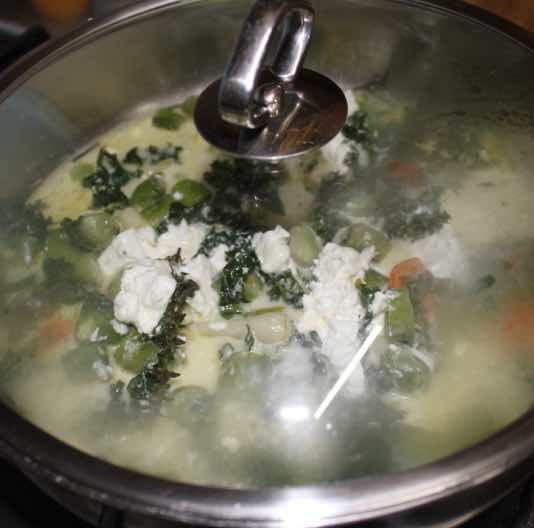
It interesting that fava beans are grown in all five of the Blue Zones of the world where vigorous old age is the norm. So we think up many ways of enjoying them.
This fava beans with cream and thyme recipe is incredibly delicious and can be rustled up in only ten minutes. If they are old and woody, forget it; so grow them yourself. It is not difficult.
Recipe for Fava bean soup
This is a very basic recipe for fava bean soup.
- Fry half a chopped onion in a generous tablespoon of butter or olive oil.
- Drop in half a tomato and a cup of chopped celery; fry gently for a few minutes.
- Add two cups of freshly-harvested young green fava beans.
- Two or three peppadews or a slither of a jalapeno chili.
- Add three cups of stock; vegetable or from chicken bones.
- A sprig of thyme and a bay-leaf.
- Simmer for ten minutes.
- Enjoy with thick slices of artisan bread and butter.
- Curcumin Prevents Aggregation of α-Synuclein, the probably cause of Parkinson's Disease.
- Habitual intake of flavonoids from food and the risk of Parkinson disease
- Lutein macular degeneration
- Zeaxanthin macular degeneration. Web: https://tinyurl.com/3mw4a7pp
- The Neuro-Ophthalmological Assessment in Parkinson’s Disease
- Parkinson's Drug May Delay Onset of Wet AMD
When browsing use right click and "Open Link in New Tab" or you may get a bad gateway signal.
Did you find this page interesting? How about forwarding it to a friendly book or food junkie? Better still, a social media tick would help.
- Bernard Preston homepage
- Legumes
- Fava Beans Nutrition
Address:
56 Groenekloof Rd,
Hilton, KZN
South Africa
Website:
https://www.bernard-preston.com